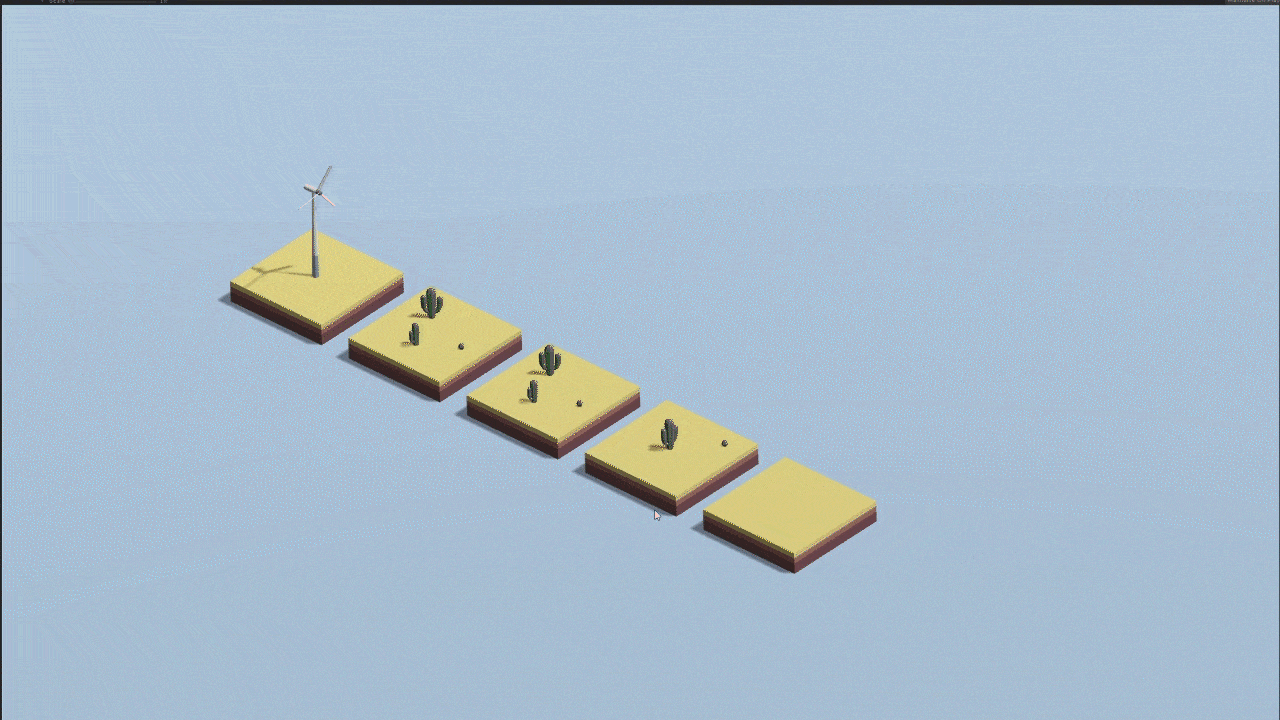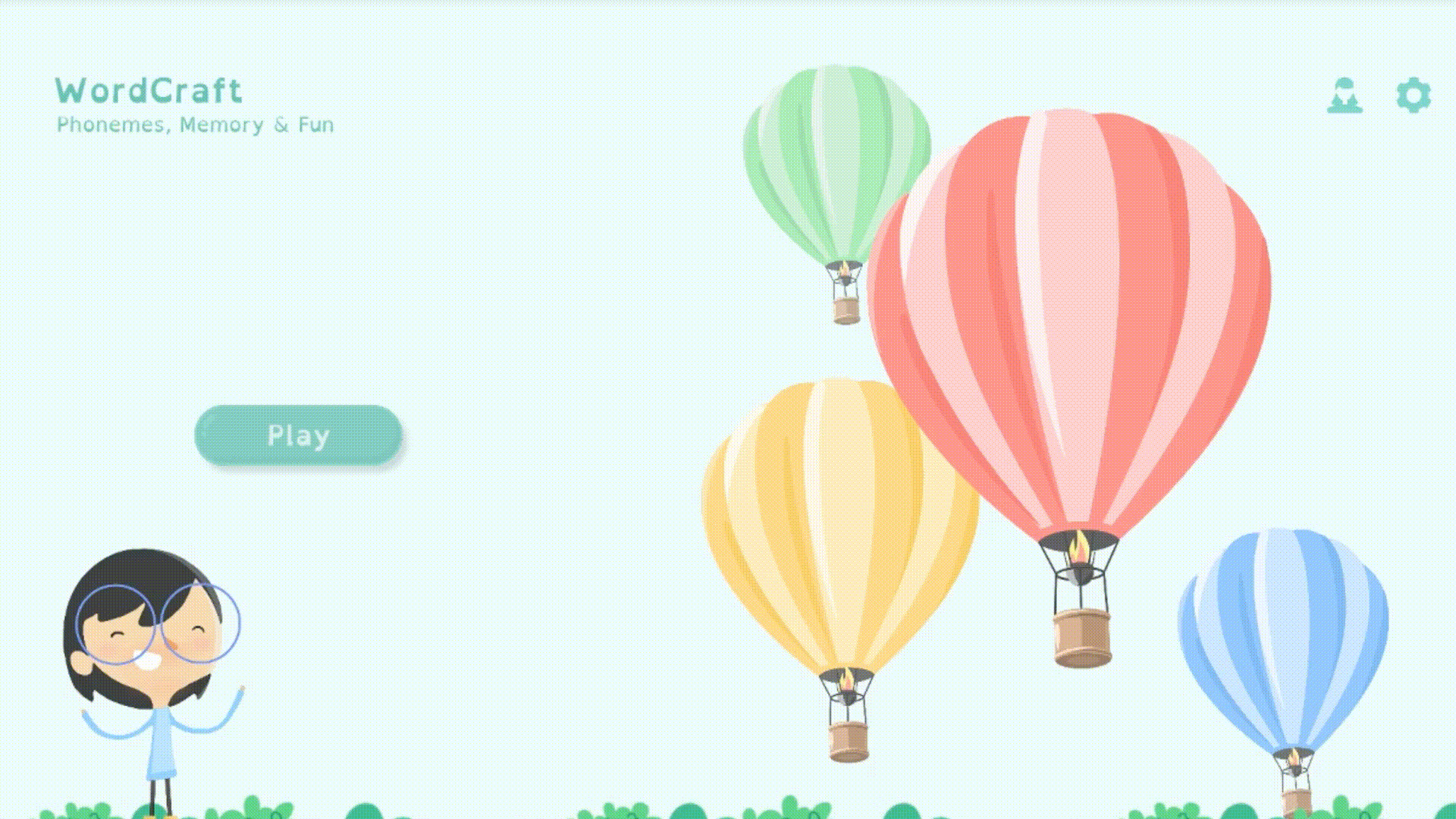

Project Brief
Partnering with Wheeling Country Day School, project WordCraft aims to present an immersive technology-based solution to facilitate the in-class learning experience for students with dyslexia. The cross-disciplinary team from CMU delivered the solutions of an interactive digital Elkonin Box exercise and a phonics memory game which are currently used in the school as the class warm-up sessions. This project is from Jan 2019 - May 2019 (5 months).
Compared to conventional teaching practices, wordcraft is exploring a transformational education by bringing learning by playing and collaborative problem solving into our project. Especially for student with dyslexia. We hope to create a friendly environment where the whole class is involved, fostering learning, and self-achievement.
My Role
UX Designer, Game Designer
Teammates
Jett Lee (Software Engineer)
Patrick Lyu (Software Engineer)
So Young Han (Designer)
Rebecca Cui (Producer)
Tools
Figma, Photoshop, Unity, Maya
Client
Wheeling Country Day School
The school is located in West Virginia and the teacher there have expertise in teaching students with dyslexia
1
Overview
The Given Task
According to our client, we are aiming to design and develop an interactive and collaborative language learning experience for students with dyslexia by digitizing the Elkonin Boxes tool, which is a validated method to enhance the language learning for people with dyslexia, but usually conducted with paper, marbles, and pens.
This exercise is already widely used in the schools to help the language education and welcomed by a lot of teachers and students. However, there are still some limitations brought by the nature of physical tool which constraints the development of ideal teaching and learning experience. In this case, our given task is to explore a proper way to digitize the Elkonin Boxes Exercise utilizing the actual class environment and technical settings in the client school.
The Platform

Chromebook
Touch-based laptop

Promethean Board
Multi-player display board
Our product should be launched on the Chromebook and Promethean Board, which are the standard classroom device-setting in the client school.
Solution Overview


Digital Elkonin Boxes for students
+ Separate management application
Individual learning without interference
Immediate correction feedback
Organized performance records


Phonics Memory Game for students
+ Embedded management system
Entertaining - learning by playing
Collaborative learning with teamed up
Customized content decided by teachers

Demo: Digital Elkonin Boxes

Demo: Phonics Memory Game
Product Delivery

Students doing the digital Elkonin Boxes Exercise

Students playing Phonic Memory Game in the class
Currently, the Digital Elkonin Boxes Exercise and the Phonic Memory Game is used as a class warm-up session and class-break activities in the Wheeling Country Day school.
* All the photos and videos in this project are approved to show properly, thanks to all the lovely volunteer students in the school.
2
Research
What is Dyslexia?
Literature Review + Expert Interview

We searched related literature and conducted interviews with 3 expert teachers from the client school, who have rich experience in teaching students with dyslexia.
In simple terms, dyslexia is a common learning disorder that makes it difficult to read, write, and spell due to problems identifying speech sounds and learning how they relate to letters and words (decoding), in spite of normal intelligence and adequate instruction. It is caused by the brain’s inability to process information received from the eyes or ears into understandable language. It does not mean that these students are lazy, or not trying hard, or not intelligent. It just means that they need to be taught in a different way.
Some typical difficulties:
Lack of Phonological Awareness, Poor Working Memory, Auditory Processing difficulties, Visual Processing difficulties, etc.
Major Pain Points of Students with Dyslexia
Based on the findings we learned from the research, we validated with the teaching expert in the client school and synthesized the key points that are most relevant and beneficial for our future design:

Students with Dyslexia
Lack of phonological awareness
Poor working memory (short time memory)
Easily get distracted (visual, audial stimuli)
Easily discouraged and low confidence in learning
What is Elkonin Boxes Exercise?
Elkonin Boxes Setting

The process of Elkonin Boxes Exercise

Key Points of Elkonin Boxes Exercise
A validated tool to help build phonological awareness by segmenting words into individual sounds/phonemes.
Widely used in schools with traditional physical format.

The action of picking the right marble and move it to the box is a physical reinforcement of segmenting the sounds.
Current physical method is doing well in engaging the students into the process and provide physical interactions, but limited in scalability and records racking.
How is Elkonin Boxes Tool Currently Used?
Classroom Settings

Contextual Inquiry of The Elkonin Boxes Exercise
We participated several sessions where teachers and students are doing the Elkonin Boxes Eercises to observe the actual class dynamics and behaviors & interactions of teahcers and students.

We found:
All the activities are held in small groups with 1 teacher and
3-5 students.
There are complex social dynamics happening:
- Students would help others when they finish their own tasks, and sometimes refer yo other's answers.
- The teacher will give feedback on each student's work one by one and encourages them a lot.
What are the painpoints of teachers?
Another major user of our product would be the teachers - we interviewed 3 teachers who conduct Elkonin Boxes Exercise frequently in thier classes.

" It's hard to keep tracking each students' performance over time using the on-time paperwork."
" When we holding more than 4 students, it's hard to check each one's progress and give feedback in time. But scalability is needed sometimes."
" Students will interference with each other because of different progress on the tasks, which is tricky for teachers to handle."
Teachers
"It would be great to provide a fun experience for students to help them be more motivated and encouraged."
3
Define
Client Request
Given Task & expected outcome
Technical constraints
Design Decisions
User Needs
User Research
Insights from iterative playtests
Synthesize the Needs of Two User Groups

Group 1
Students with Dyslexia

Group 2
Teachers
Need more motivation and encouragement in the learning experience.
Need to be more concentrated on the exercise: decrease peer interference and other distractions.
Keep the social element in the experience: peer-study, collaboration, interaction with teachers, etc.
Extend class scalability.
Track student's performance over time.
Flexibility in manage class content.
Keep and emphasized the educational value of the digital version.
Here Comes the Challenges
The Solution Mapping


Digital Elkonin Boxes for students
+ Separate management application
for teachers

Phonics Memory Game for students
+ Embedded management system
for teachers
That’s how we come up with the idea of bringing this experience into two products, and they could be used in sequence or used separately according to the teacher’s needs.
Design - Digital Elkonin Box
4
- Individual Learning without interference
- Limited Gamification

Digital Elkonin Boxes for students
+ Separate management application for teachers
Based on previous discussions, the digital Elkonin Boxes will be deployed on the Chromebook for individual learning,
I started with:
Mapping out the product structure and major features:


Firstly,let's Look into the Elkonin Boxes exercise
Wireframing & Paper Prototyping

Interaction Flow Map of the Exercise
After several rounds of iteration and testing, we finalized the user flow of the digital Elikonin Boxes exercise. I organized our flow design into this interaction flow map to help the developer team has the same understanding as we do. This map is detailed in each step and clarifies interaction questions like the digital box boundary definition, error reaction, feedback delay time, and auto snapping to center, etc.

Theme & Art Iteration

Key Features of Digital Elkonin Boxes

More Concentration
- Camera zooms in: only view the boxes when doing the exercise
- Simple & Clean interface with dyslexia-friendly color
- Less Competition & Interference from peers

Sense of Achievement
- Creating new lands by finishing exercises
- Dynamic map: students would got diverse results
- Camera zooms out: view the lands story when finish the exercise

Immediate Feedback
- Automatic correction for the answer instantly
- Snapping to the box centre
- keeps the moving-based interfaction to imitate the physical version

Secondly,let's Look into the Teacher's System
Wireframing & Level Mapping



Typical Use Cases




Testing with teachers and students
Considering our specific user group, we never only rely on our assumptions to design.
We validated the user's need and also every design decision through different phases of user testing.
During our iterations, we respect the user's suggestions and feedbacks as our input to have solid design solutions. We've fixed usability issues for teachers including the word list procedural visualization and performance lookup detail levels. And through testing, we realized simple and clear is the key for the user interface of students with dyslexia in the learning context.




Design - Phonics Memory Game
5

Phonics Memory Game for students
+ Embedded management system for teachers
- Class Dynamic: Collaborative Mechanism
- Gamification: Learning through Playing
Based on our previous discussion, we are separating the solution into two sections: the Digital Elkonin Boxes as we introduced above is focusing on the individual learning experience without interference and get immediate feedback and encouragement; the other section is a Phonics Memory Game which would be an educational game with more fun element, helping build up the social dynamics which existed in the original Elkonin Boxes Exercise.
Game Design: one design challenge is to come up with a game mechanism to help students enhance short term memory and sound decoding but also have fun.
Class Dynamic: since we missed the social element existing in the traditional Elkonin Boxes exercises, we are targeting to utilize the game to create a collaborative and interactive class atmosphere.



Gameplay on Promethean Board for Students
Embedded Preparation System for Teacher
The Ideation Process
Memory Game Mechanism

Gameplay Prototyping & Playtesting:



Game Theme

Design Highlights



Create a course

Register new word

Enter a course
Class Dynamics

The student will team up into different teams and each team and each team member would take turns to guess the location of the phoneme. If they guess correctly, they could continue to guess the next one; If not, then the other team could take the turn. There would be a count for the correct number of a full word for each team, but we don’t emphasize the win. We expect that each player could have fun and obtain accomplishment from each word, this also is proved in our playtest in the school with students.
Here are the students helping us to playtest the game in teams:




* Photos taken @ wheeling country day school, all are allowed to show by the student and parents.

The teacher represented our client, subject expert, and user of our product. Sha highly recognized the educational value of this game by taking advantage of the segmenting sounds method from Elkonin Boxes and also adding the element of memory challenge, which is proved in our playtest that students are trying to separating words into phonemes to win the game. Besides, students are really enjoying the game with fun, and they actually don't care about winning but help each other to finish each task, which brought a lot of nice collaborative atmosphere into the class. In general, they are very satisfied with our design and delivery.